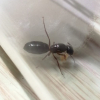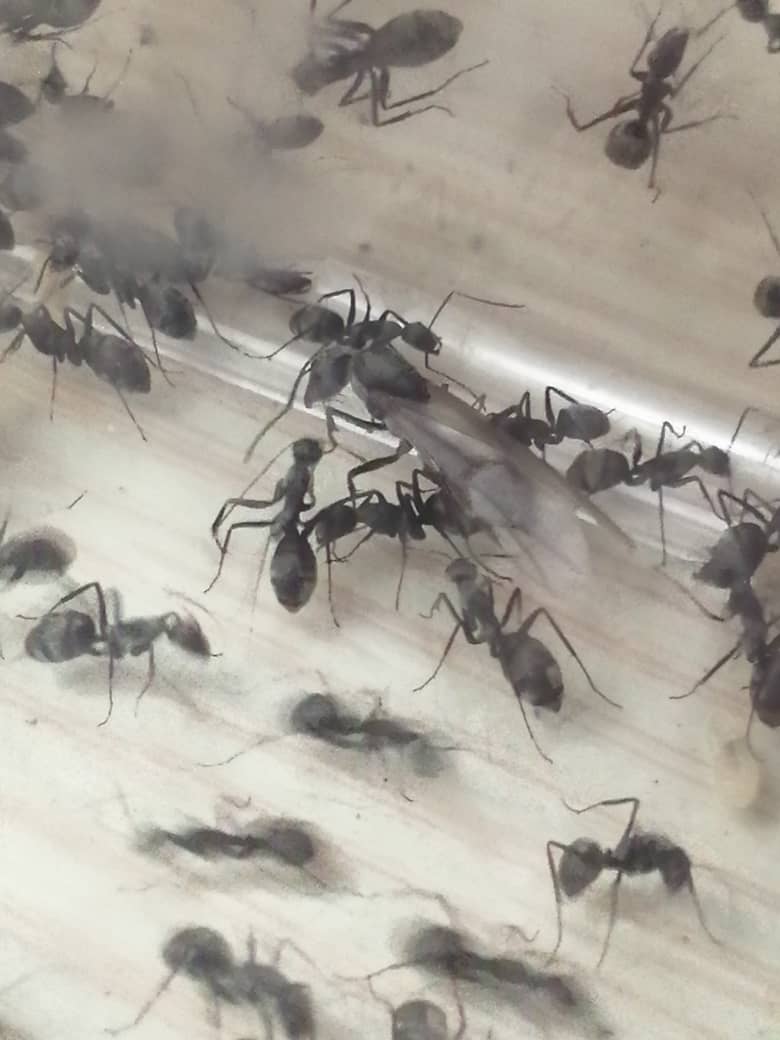I don't know if there's any in pic but, Lepisiota cf rothneyi now has bigger majors than before!
- Formiculture.com
- Forums
- Gallery
- Members
- Member Map
- Chat

I don't know if there's any in pic but, Lepisiota cf rothneyi now has bigger majors than before!
Yeah, the lemon thing is a myth. That’s like trying to kill a vampire with a mango. What interest would a hemolymph sucking parasite have in fruit??Lemons don’t actually work, at least according to ANTdrew.
Yeah, the lemon thing is a myth. That’s like trying to kill a vampire with a mango. What interest would a hemolymph sucking parasite have in fruit??Lemons don’t actually work, at least according to ANTdrew.
Ok, I'll try to find another way to get the mites off.
I think the citric acid or something is supposed to kill them but what’s to guarantee they even come in contact with the lemon?Yeah, the lemon thing is a myth. That’s like trying to kill a vampire with a mango. What interest would a hemolymph sucking parasite have in fruit??Lemons don’t actually work, at least according to ANTdrew.
Well, this is a rough start for a journal, the Carebara (Oligomyrmex) queen has sadly passed away ![]() . I will preserve her in alcohol.
. I will preserve her in alcohol.
NOOOOOOWell, this is a rough start for a journal, the Carebara (Oligomyrmex) queen has sadly passed away
. I will preserve her in alcohol.
Quick update: The Anochetus queen ate a fruit fly I gave her, hopefully we'll expect eggs soon. And I had to move my Camponotus irritans colony to a new test tube because their old one is getting moldy and they are very crowded in there, but they don't seem to be interested in moving yet.
Unfortunately, i had to cancel the Camponotus irritans colony's move because the colony isn't interested in moving yet and the tape holding the two test tubes together had a tiny hole in it which allows air to come but it's too small for the ants to get out but, there are wild Pharoah ants roaming around and the hole is big enough for them to get in, there is also a chance that they can chew through the tape and escape. Though I can use an outworld or something to attach or put the test tubes together, the only one I have left is 'cursed'.
Though there is good news! The Camponotus parius alates finally arrived! It was a female alate (i.e. a virgin queen) she probably eclosed a few minutes to an hour ago as she hasn't learnt how to walk yet. And, the Anochetus queen finally laid eggs! It seems that the fruit fly she ate was the trick (thanks to Kaelwizard for suggesting it), there were approximately 3-6 eggs.
Jealousy fills meUnfortunately, i had to cancel the Camponotus irritans colony's move because the colony isn't interested in moving yet and the tape holding the two test tubes together had a tiny hole in it which allows air to come but it's too small for the ants to get out but, there are wild Pharoah ants roaming around and the hole is big enough for them to get in, there is also a chance that they can chew through the tape and escape. Though I can use an outworld or something to attach or put the test tubes together, the only one I have left is 'cursed'.
Though there is good news! The Camponotus parius alates finally arrived! It was a female alate (i.e. a virgin queen) she probably eclosed a few minutes to an hour ago as she hasn't learnt how to walk yet. And, the Anochetus queen finally laid eggs! It seems that the fruit fly she ate was the trick (thanks to Kaelwizard for suggesting it), there were approximately 3-6 eggs.
Jealousy fills meUnfortunately, i had to cancel the Camponotus irritans colony's move because the colony isn't interested in moving yet and the tape holding the two test tubes together had a tiny hole in it which allows air to come but it's too small for the ants to get out but, there are wild Pharoah ants roaming around and the hole is big enough for them to get in, there is also a chance that they can chew through the tape and escape. Though I can use an outworld or something to attach or put the test tubes together, the only one I have left is 'cursed'.
Though there is good news! The Camponotus parius alates finally arrived! It was a female alate (i.e. a virgin queen) she probably eclosed a few minutes to an hour ago as she hasn't learnt how to walk yet. And, the Anochetus queen finally laid eggs! It seems that the fruit fly she ate was the trick (thanks to Kaelwizard for suggesting it), there were approximately 3-6 eggs.
Sent from my CPH2201 using Tapatalk
Don't worry, keep looking. You'll eventually find some. Also, queens will occasionally be found under logs, rocks, and other stuff, you just need to get lucky. And that's literally how I managed to find hundreds of trap jaw queens (I didn't catch them all since I don't have enough test tubes).
I do. But the problem is my neighborhood is filled with P. longicornis and A. gracillipes so there are very few ants for me left.Don't worry, keep looking. You'll eventually find some. Also, queens will occasionally be found under logs, rocks, and other stuff, you just need to get lucky. And that's literally how I managed to find hundreds of trap jaw queens (I didn't catch them all since I don't have enough test tubes).Jealousy fills meUnfortunately, i had to cancel the Camponotus irritans colony's move because the colony isn't interested in moving yet and the tape holding the two test tubes together had a tiny hole in it which allows air to come but it's too small for the ants to get out but, there are wild Pharoah ants roaming around and the hole is big enough for them to get in, there is also a chance that they can chew through the tape and escape. Though I can use an outworld or something to attach or put the test tubes together, the only one I have left is 'cursed'.
Though there is good news! The Camponotus parius alates finally arrived! It was a female alate (i.e. a virgin queen) she probably eclosed a few minutes to an hour ago as she hasn't learnt how to walk yet. And, the Anochetus queen finally laid eggs! It seems that the fruit fly she ate was the trick (thanks to Kaelwizard for suggesting it), there were approximately 3-6 eggs.
Sent from my CPH2201 using Tapatalk
I do. But the problem is my neighborhood is filled with P. longicornis and A. gracillipes so there are very few ants for me left.
Don't worry, keep looking. You'll eventually find some. Also, queens will occasionally be found under logs, rocks, and other stuff, you just need to get lucky. And that's literally how I managed to find hundreds of trap jaw queens (I didn't catch them all since I don't have enough test tubes).
Jealousy fills meUnfortunately, i had to cancel the Camponotus irritans colony's move because the colony isn't interested in moving yet and the tape holding the two test tubes together had a tiny hole in it which allows air to come but it's too small for the ants to get out but, there are wild Pharoah ants roaming around and the hole is big enough for them to get in, there is also a chance that they can chew through the tape and escape. Though I can use an outworld or something to attach or put the test tubes together, the only one I have left is 'cursed'.
Though there is good news! The Camponotus parius alates finally arrived! It was a female alate (i.e. a virgin queen) she probably eclosed a few minutes to an hour ago as she hasn't learnt how to walk yet. And, the Anochetus queen finally laid eggs! It seems that the fruit fly she ate was the trick (thanks to Kaelwizard for suggesting it), there were approximately 3-6 eggs.
Sent from my CPH2201 using Tapatalk
Sent from my CPH2201 using Tapatalk
That's sad. But I have heard that Anoplolepis gracilipes can wipe out all Paratrechina longicornis in their territory.
Quick Update: I noticed that the Camponotus irritans colony also has mites ![]() .
.
Edited by SYUTEO, July 5 2021 - 2:24 AM.
They coexist which sucks. I think the mites are phoretic.That's sad. But I have heard that Anoplolepis gracilipes can wipe out all Paratrechina longicornis in their territory.I do. But the problem is my neighborhood is filled with P. longicornis and A. gracillipes so there are very few ants for me left.Don't worry, keep looking. You'll eventually find some. Also, queens will occasionally be found under logs, rocks, and other stuff, you just need to get lucky. And that's literally how I managed to find hundreds of trap jaw queens (I didn't catch them all since I don't have enough test tubes).Jealousy fills meUnfortunately, i had to cancel the Camponotus irritans colony's move because the colony isn't interested in moving yet and the tape holding the two test tubes together had a tiny hole in it which allows air to come but it's too small for the ants to get out but, there are wild Pharoah ants roaming around and the hole is big enough for them to get in, there is also a chance that they can chew through the tape and escape. Though I can use an outworld or something to attach or put the test tubes together, the only one I have left is 'cursed'.
Though there is good news! The Camponotus parius alates finally arrived! It was a female alate (i.e. a virgin queen) she probably eclosed a few minutes to an hour ago as she hasn't learnt how to walk yet. And, the Anochetus queen finally laid eggs! It seems that the fruit fly she ate was the trick (thanks to Kaelwizard for suggesting it), there were approximately 3-6 eggs.
Sent from my CPH2201 using Tapatalk
Sent from my CPH2201 using Tapatalk
Quick Update: I noticed that the Camponotus irritans colony also has mites.
Whaaat!? ![]() The two ants can coexist!? Well, I hope that the mites are phoretic.
The two ants can coexist!? Well, I hope that the mites are phoretic.
Edited by SYUTEO, July 5 2021 - 2:39 AM.
Here's a pic of an alate of my Camponotus parius colony (I know the pic is blurry because the ants are running around)

Well, this is weird, the Camponotus irritans colony ALREADY has majors! Is it even possible for a Camponotus colony with around 14-16 workers to have majors?
Second update: The Anochetus queen made a chamber for herself, I could still see her but not as easy (because the color of the soil is very similar to the color of the queen (I used that soil because I wanted to see if she has laid eggs, since the eggs are white and the soil is black it makes it very easy to spot any eggs.).). No pics for now as I don't want her to eat the eggs.
Edit: I actually noticed something peculiar, the mites that are on the Camponotus irritans colony only attached on the ants' gaster, head and mandibles but not on the ants' legs, thorax and antennae.
Edited by SYUTEO, July 7 2021 - 11:40 PM.
I have heard of someone getting majors in the first batch of eggs.
What!? Really!?
It was an American species and this doesn’t normally happen, but yeah majors can come fairly early in Camponotus.What!? Really!?
I have heard of someone getting majors in the first batch of eggs.
0 members, 1 guests, 0 anonymous users